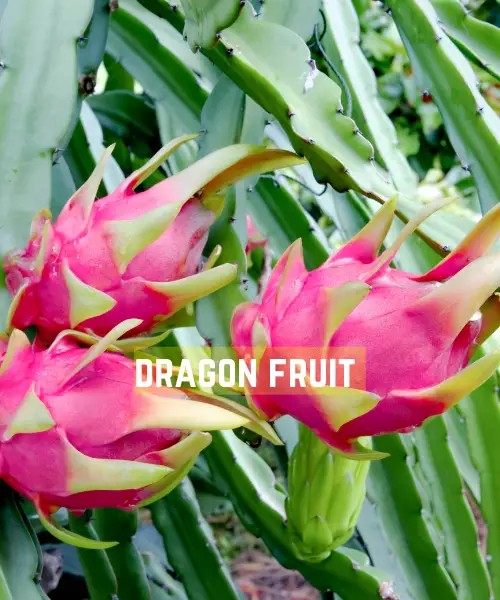The exotic, colorful appearance and distinct flavor of dragon fruit have made it more and more popular in recent years.
These days, dragon fruit may be found in many grocery shops, but cultivating your own from seed is quite satisfying.
Not only does it allow you to enjoy the freshest possible fruit, but it’s also a fun and rewarding gardening project.
What is a Dragon Fruit?
Dragon fruit, also known as pitaya or strawberry pear, is a member of the cactus family and is native to Central and South America. It comes in various varieties, with the most common being the red-skinned dragon fruit with white flesh and the yellow-skinned dragon fruit with red flesh.

Dragon fruit plants are unique in many ways. They are climbing cacti that can reach impressive heights, making them excellent candidates for growing on trellises or against walls. The plants produce stunning, night-blooming flowers that are not only beautiful but also short-lived, typically lasting only one night before closing up again.
Starting with Dragon Fruit Seeds
The first step in your dragon fruit cultivation journey is to obtain high-quality seeds. You can either purchase seeds from a reputable nursery or online supplier, or you can extract them from a fresh dragon fruit. If you choose to extract the seeds yourself, make sure to use a ripe fruit and carefully remove the small, black seeds from the flesh.

Once you have your seeds, it’s time to prepare them for germination. Dragon fruit seeds have a tough outer coating that can inhibit germination, so it’s essential to scarify them before planting. Scarification involves creating a small nick or scratch on the seed coat, allowing water to penetrate and kickstart the germination process.
There are a few methods you can use for scarification:
1. Sandpaper method: Gently rub the seeds against a piece of sandpaper or an emery board to create small abrasions on the seed coat.
2. Soaking method: Soak the seeds in water for 24-48 hours. This can help soften the seed coat and make it more permeable.
3. Acid treatment: Carefully soak the seeds in a diluted solution of sulfuric acid or vinegar for a short period, then rinse them thoroughly. This method should be handled with extreme caution and is not recommended for beginners.
Once your seeds are scarified, it’s time to plant them.
Planting and Germination
Dragon fruit seeds can be planted directly in well-draining soil or started in seed trays for easier transplanting later on. If you’re planting directly in the ground, choose a sunny spot with well-draining soil and amend it with compost or other organic matter to improve drainage and fertility.
If you’re starting your seeds in trays, use a high-quality seed-starting mix and ensure that the trays have adequate drainage holes. Plant the seeds about 1/4 to 1/2 inch deep, spacing them a few inches apart. Cover the seeds with soil and water gently.
Regardless of your planting method, it’s crucial to maintain consistent soil moisture during the germination process. Dragon fruit seeds can take anywhere from 10 days to several weeks to germinate, so patience is key.
Once the seedlings emerge, provide them with bright, indirect light and continue to keep the soil moist but not waterlogged. When the seedlings develop their first set of true leaves, you can begin gradually exposing them to more direct sunlight to help them acclimate.
Transplanting and Caring for Young Plants
If you started your seeds in trays, it’s time to transplant them once they have developed a robust root system and are about 6-8 inches tall. Choose a well-draining potting mix or prepare a sunny spot in your garden with amended soil.
When transplanting, handle the seedlings gently and avoid disturbing the roots as much as possible. Dig a hole slightly larger than the root ball and plant the seedling at the same depth it was growing in the tray or pot. Water the plant thoroughly after transplanting to help settle the soil and reduce transplant shock.
As your dragon fruit plants continue to grow, it’s essential to provide them with the right care and conditions. Here are some key factors to consider:
1. Sunlight: Dragon fruit plants thrive in full sun, requiring at least 6-8 hours of direct sunlight per day.
2. Water: Consistent moisture is crucial, but be careful not to overwater. Allow the soil to dry out slightly between waterings, and ensure that the plant’s potting mix or soil drains well.
3. Temperature: Dragon fruit plants prefer warm temperatures, ideally between 65°F and 95°F (18°C and 35°C). They can tolerate cooler temperatures but may become dormant.
4. Fertilizer: Apply a balanced, water-soluble fertilizer every 4-6 weeks during the growing season to provide the necessary nutrients for healthy growth.
5. Support: As your dragon fruit plants grow, they will need support in the form of a trellis, stake, or sturdy wall. Dragon fruit plants are climbers and will require something to cling to as they mature.
Flowering and Fruit Production
One of the most exciting aspects of growing dragon fruit is the anticipation of seeing those stunning, night-blooming flowers and eventually harvesting the delicious fruit. However, it’s important to note that dragon fruit plants typically don’t produce flowers and fruit until they are 2-3 years old or older.
When your plant is mature enough, you’ll notice large, fragrant buds forming on the ends of the stems or branches. These buds will open into beautiful, white or yellow flowers that only bloom at night and close up again by dawn. It’s essential to hand-pollinate these flowers to ensure fruit production, as the natural pollinators may not be active at night.
To hand-pollinate, use a small, soft brush or cotton swab to transfer pollen from the anthers (male part) to the stigma (female part) of the flower. Do this in the evening when the flowers are open, and repeat the process for several nights to increase the chances of successful pollination.
If pollination is successful, you’ll see the fruit beginning to form and develop over the next few weeks. Dragon fruit takes several months to fully mature, so patience is key. When the fruit is ripe, it will turn a vibrant red or yellow color (depending on the variety) and have a slightly soft texture.
Harvesting and Enjoying Your Dragon Fruit

When it comes time to harvest your dragon fruit, it’s important to handle the fruit carefully to avoid bruising or damaging it. Use a clean, sharp knife or pruning shears to cut the fruit from the plant, leaving a small stem attached.
Fresh dragon fruit can be enjoyed in a variety of ways. Its unique, slightly sweet flavor and crunchy texture make it a delightful addition to fruit salads, smoothies, or simply enjoyed on its own. You can also use dragon fruit to create refreshing sorbets, jams, or even savory dishes like salsa or ceviche.
With its striking appearance and exotic flavor, dragon fruit is sure to be a conversation starter and a delightful addition to your garden or home. Growing dragon fruit from seed may require patience and dedication, but the rewards of enjoying fresh, homegrown fruit are truly unmatched.




